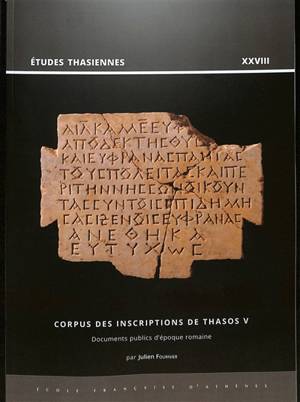
- Afhalen na 1 uur in een winkel met voorraad
- Gratis thuislevering in België vanaf € 30
- Ruim aanbod met 7 miljoen producten
- Afhalen na 1 uur in een winkel met voorraad
- Gratis thuislevering in België vanaf € 30
- Ruim aanbod met 7 miljoen producten
Omschrijving
Comment s'effectua l'intégration d'une cité grecque dans l'empire romain ? Quelles en furent les étapes et de quelles transformations Institutionnelles et sociales s'accompagna-t-elle ? Tels sont les principaux enjeux qu'explore ce fascicule du Corpus des inscriptions de Thasos (CITh V), qui réunit les documents publics d'époque romaine (Ier s. av. J.-C.-IVe s. apr. J.-C). Cent trois textes, auparavant dispersés entre un grand nombre de recueils et d'articles, y sont réédités, traduits, commentés et illustrés par une documentation graphique et photographique entièrement renouvelée. Une série de lettres émises par les autorités romaines dessine les étapes de l'incorporation de Thasos dans l'empire en formation, de la guerre contre Mithridate à la création de la province de Thrace. Toutes les autres inscriptions émanent de la cité elle-même. Le faciès de la documentation rend compte des évolutions du modèle civique grec à l'époque de l'hégémonie romaine. Si les règlements se font plus rares qu'aux époques antérieures, les décrets honorifiques et les bases de statues constituent désormais une large part de l'épigraphie publique. Répondant aux nombreuses dédicaces à caractère édilitaire, ces inscriptions témoignent de la dépendance accrue de la cité envers un groupe de notables qui financent l'entretien de la ville et le fonctionnement d'institutions encore bien vivantes. En fin d'ouvrage, un appendice paléographique retrace les évolutions de la gravure depuis les grands textes du Ier s. av. J.-C. jusqu'à la fin de l'épigraphle publique, à l'époque constantinienne. Un appendice prosopographlque recense plus de deux cent cinquante individus, hommes et femmes. Une série d'indices détaillés facilite la consultation du volume.
How did the integration of a Greek city into the Roman Empire take place ? What were the steps involved and what institutional and social transformations accompanied it ? These are the main issues explored in this volume of the Corpus of Inscriptions from Thasos (CITh V), which brings together public documents from the Roman era (1st century BC - 4th century AD). One hundred and three texts, previously scattered among numerous collections and articles, are meticulously edited, translated, commented on, and Illustrated with completely renewed graphic and photographic documentation. A series of letters issued by Roman authorities outline the successive stages of Thasos' incorporation into the emerging empire, from the war against Mithridates to the creation of the province of Thrace. All other inscriptions originate directly from the city itself. The content and presentation of these documents reflects the evolution of the Greek civic model during the period of Roman hegemony. While regulations are not as common as in previous eras, honorary decrees and inscriptions on the bases of statues now constitute a significant portion of public epigraphy. In response to the numerous dedications with an edilitarian character, these inscriptions demonstrate the increased dependence of the city on a group of notables who finance the maintenance and the functioning of its still active institutions. At the end of the book, a paleographic appendix traces the development of engraving from the major texts of the 1st century BC until the conclusion of public epigraphy in the Constantinian period. Additionally, a prosopographic appendix identifies and catalogs over 250 individuals, both men and women. A series of detailed indexes facilitates the consultation of the volume.
Specificaties
Betrokkenen
- Auteur(s):
- Uitgeverij:
Inhoud
- Aantal bladzijden:
- 381
- Taal:
- Frans
- Reeks:
- Reeksnummer:
- nr. 5
Eigenschappen
- Productcode (EAN):
- 9782869585874
- Verschijningsdatum:
- 30/08/2023
- Uitvoering:
- Paperback
- Formaat:
- Trade paperback (VS)
- Afmetingen:
- 210 mm x 300 mm
- Gewicht:
- 644 g

Alleen bij Standaard Boekhandel
Beoordelingen
We publiceren alleen reviews die voldoen aan de voorwaarden voor reviews. Bekijk onze voorwaarden voor reviews.











